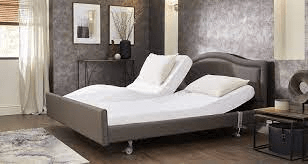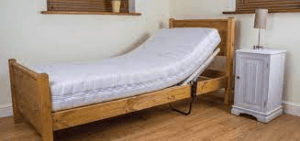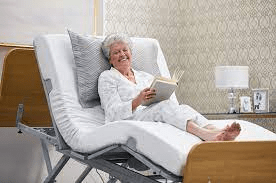When it comes to choosing the right bed to suit individual needs, particularly for those with mobility issues or specific health conditions, the decision often narrows down to profiling beds and adjustable beds. Both options offer unique features that can make a significant difference in comfort, ease of use, and overall well-being. However, the terms are often used interchangeably, leading to confusion. So, what is the key difference between between a profiling bed and an adjustable bed? This comprehensive guide aims to shed light on the topic, helping you make an informed decision.
What is a Profiling Bed?
A profiling bed is a specialized type of bed primarily used in healthcare settings like hospitals, nursing homes, and assisted living facilities. These beds are designed with multiple sections that can be adjusted independently to offer specific positions that cater to medical needs. The key features of most profiling beds include:
- Backrest Adjustment: The head of the bed can be raised or lowered to assist with breathing, digestion, and posture.
- Knee Break: This feature allows the lower part of the bed to bend at the knees, preventing the user from sliding down when the backrest is elevated.
- Variable Height: The entire bed can be raised or lowered, facilitating easier transfers to and from the bed.
- Tilt Function: Some profiling beds have a tilting feature that helps in pressure relief and circulatory benefits.
Pros of Profiling Beds
- Ideal for long-term bed-bound patients.
- Provides significant medical benefits.
- Usually comes with side rails for added safety.
Cons of Profiling Beds
- Generally bulkier and less aesthetically pleasing.
- More suited for healthcare settings than for home use.
- Typically more expensive due to the specialized features.
What is an Adjustable Bed?
Adjustable beds are more commonly found in residential settings and are geared towards enhancing comfort and lifestyle. These beds offer the flexibility to raise or lower the head and foot sections of standard bed to different levels but do not usually offer as many specialized positioning options as profiling beds. Key features include:
- Head Adjustment: Elevate the head section to read, watch TV, or alleviate conditions like sleep apnea or snoring.
- Foot Adjustment: Raise the foot section to relieve back pain or improve circulation.
- Massage and Heat Features: Some high-end models come with built-in massage options and heating pads.
Pros of Adjustable Beds
- More aesthetically pleasing and blends well with home décor.
- Offers lifestyle benefits like better comfort for reading or watching TV.
- Usually easier to assemble and disassemble.
Cons of Adjustable Beds
- Not as medically specialized as profiling beds.
- May not come with safety features like side rails.
What is the Difference Between a Profiling Bed and an Adjustable Bed?
Now that we’ve covered the basics of each, let’s dive into the key differences:
Intended Use
- Profiling Beds: Primarily intended for medical use and are equipped with features designed to alleviate or manage health conditions.
- Adjustable Beds: More focused on lifestyle and comfort rather than specific medical needs.
Number of Adjustable Sections
- Profiling Beds: Typically have more adjustable sections including head, knees, and height.
- Adjustable Beds: Usually limited to head and foot adjustments.
Aesthetic Appeal
- Profiling Beds: Generally more clinical in appearance.
- Adjustable Beds: Designed to fit seamlessly into home settings, often with a wider range of material and color options.
Cost
- Profiling Beds: Due to their specialized features, they tend to be more expensive.
- Adjustable Beds: Generally more affordable but can become expensive with added luxury features.
Portability and Storage
- Profiling Beds: Bulkier and often require professional installation.
- Adjustable Beds: Easier to move, disassemble, and store.
Who Should Consider Each Type?
Profiling Beds
- Individuals with severe mobility issues.
- Those who require long-term bed rest.
- Patients with specific medical conditions like spinal injuries or severe respiratory issues.
Adjustable Beds
- Those looking to enhance comfort for activities like reading, watching TV, or using a laptop.
- Individuals with mild to moderate health issues like back pain, snoring, or poor circulation.
- Those who wish to integrate their bed into a smart home system for added convenience.
What are Electric Profiling Beds?
Electric profiling beds are specialized medical beds featuring electronically controlled multiple adjustable sections. These beds are designed to provide the optimal position for various medical conditions and healthcare needs. A standard electric profiling bed can adjust the backrest, the footrest, and the overall height of the mattress platform the bed. Some models also include more advanced features like lateral tilting and knee breaks.
What are Double Profiling Beds?
Double profiling beds, as the name implies, are double-sized beds equipped with full range of profiling features. Just like single profiling beds, these beds have adjustable sections that can be raised or lowered to meet specific needs, whether for medical purposes or for daily activities like reading or watching television. The unique feature of a double profiling bed is that it offers dual controls, allowing each side of the bed to be adjusted independently.
What is Anti-Trendelenburg?
The Anti-Trendelenburg position is essentially a seated position, the opposite of the Trendelenburg position. In the Trendelenburg position, a patient lies on their back with the legs elevated higher than the head. Conversely, in the Anti-Trendelenburg position, the patient’s head is elevated higher than their legs while lying on their back.
Advantages of the Anti-Trendelenburg Position
Improved Respiratory Function
By elevating the upper body, the Anti-Trendelenburg position can help in reducing respiratory stress, facilitating easier breathing.
Better Surgical Access
For specific procedures involving the upper body, the Anti-Trendelenburg position offers surgeons better access and visibility, making their work more straightforward and potentially more successful.
Mattresses
When it comes to a good night’s sleep, few things are as crucial as the mattress you lie on. Often considered just a part of bedroom furniture, mattresses are, in fact, an essential component of your overall health and well-being. With a myriad of options available in the market, understanding the different types, features, and health benefits can guide you in making an informed decision.
Types of Mattresses
Innerspring Mattresses
These are traditional mattresses featuring a steel coil support system. They are known for their durability and wide availability. However, they can be uncomfortable for people with back or joint pain.
Memory Foam Mattresses
Memory foam mattresses conform to the shape of the body, providing excellent support. They are particularly good for people with muscle pain or joint issues.
Latex Mattresses
Made from natural or synthetic rubber, latex mattresses offer firmness and support. They are good for people who prefer extra support and a firmer sleeping surface.
Hybrid Mattresses
A blend of innerspring and foam, hybrid mattresses offer a middle-ground solution for those who want a bit of both worlds—bounce and contouring.
Air Mattresses
Not to be confused with inflatable beds, these mattresses allow you to adjust their firmness through air chambers. They are often recommended care bed used for people with spinal issues.
Adjustable Beds
While not a mattress type per se, adjustable beds enable you to have adjustable height or change the mattress’s angle, often ideal for medical conditions or lifestyle preferences like reading or watching TV in bed.
Health Benefits
Spinal Alignment
A good mattress can help in maintaining the natural alignment of the spine, thereby reducing back pain.
Pressure Relief
Memory foam and latex mattresses distribute body weight evenly over whole bed, relieving pressure points like the hips and shoulders.
Allergy Prevention
Some mattresses come with hypoallergenic materials that help in minimizing the risks of allergic reactions.
Improved Sleep Quality
With a comfortable mattress, the chances and risk of falling and waking up in the middle of the night are less, leading to better sleep quality.
Conclusion
When contemplating the question, “What is the difference between a profiling bed and an adjustable bed?” it’s essential to consider your specific needs, lifestyle, and health conditions. Profiling beds offer specialized medical features ideal for healthcare settings or those with severe medical issues, while adjustable beds are more suited for home use, offering a comfortable and flexible sleeping solution. Understanding these differences can guide you towards making an informed decision that significantly impacts your quality of life.


